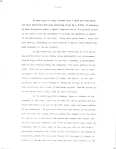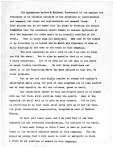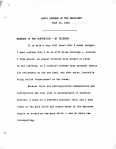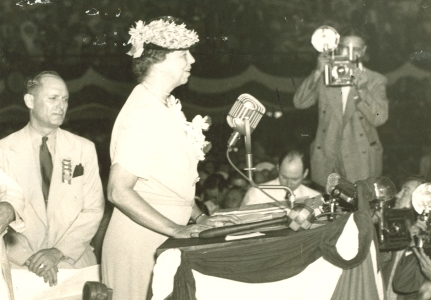You are currently browsing the tag archive for the ‘1932’ tag.
1932 Presidential Campaign
Franklin Roosevelt’s nomination for President by the Democratic Convention in Chicago in July 1932 led to one of the momentous campaigns in American political history.
Saddled with responsibility for the Depression, President Hoover would have been vulnerable to almost any opponent in 1932. FDR’s advisors were unanimous in urging him to play it safe and wage a front porch campaign; his running mate, John Nance Garner of Texas, told him, “All you have got to do is stay alive until election day.”
But from his first political venture in upstate New York, FDR had personally exulted in active campaigning, and in 1932 he felt the times and the mood of the country required no less.
Accordingly he campaigned the length and breadth of the land, carrying his message into forty-one states and making a score of major addresses as well as hundreds of whistle-stop appearances. It was the most active presidential campaign to that time.
Some of the positions FDR advocated for during the campaign, such as a commitment to lower taxes, balance the budget, and cut the Federal bureaucracy by 25%, came back to haunt him later. But his energy and personal charm nevertheless carried him to a sweeping victory on November 8, winning forty-two of the forty-eight states, an electoral vote margin of 472 to 59, and a popular vote of 22.8 million to Hoover’s 15.7 million.
Roosevelt Campaign Posters
Franklin Roosevelt is the only American president elected to four terms. The campaign posters seen above represent all four of his presidential campaigns—1932, 1936, 1940, and 1944. Before the era of television and the internet, campaign posters were one of the primary visual tools used by presidential candidates. These posters reflected key messages associated with the candidate. The Roosevelt Library’s collection of political campaign posters suggests some of the prominent themes employed by FDR’s campaign team during four very different political years.
1932
During Roosevelt’s first campaign in 1932, his poster designs were simple with little color and an understated, straightforward message. This election took place at the lowest point of the Great Depression and FDR campaigned as a “Progressive Candidate” promising to be a “Man of Action” with policies to combat the economic crisis.
1936
By 1936, the economy was improving and unemployment was down. Roosevelt entered his first re-election campaign stressing a message of continuity. The nation was encouraged to continue moving “Forward with Roosevelt.” Another poster with a photograph of FDR working at his desk— simply entitled “Re-elect ROOSEVELT”— aimed to resonate with Americans eager for the President to continue what he had started.
1940
The threat of American entry into World War II was a key issue when Roosevelt ran for an unprecedented third term in 1940. Many of his 1940 campaign posters have an overtly patriotic design. Stars along with red and white and blue colors are more prominent. The campaign placed greater emphasis on voting “Straight Democratic” to “Protect America.”
Throughout his presidency, FDR supported policies that increased the ranks of organized labor. Labor’s growing importance to the Democratic Party is reflected in the union label’s presence on the President’s campaign posters. In 1940, for the first time, the label appeared on all of Roosevelt’s posters.
1944
With America at war, the 1944 campaign varied significantly from the previous three. War, victory, and peace became major poster themes. James Montgomery Flagg’s iconic Uncle Sam image was translated into a Roosevelt campaign symbol. A poster produced by the Congress of Industrial Organizations (CIO) touted FDR as “1A In Our Draft.” A “Vote Democratic” poster employed a large “V”—associated during the war with the popular slogan “V for Victory.”
The FDR Presidential Library and Museum and the Roosevelt Institute are pleased to announce “FDR’s 4 CAMPAIGNS,” a free public forum on October 21, 2012. The forum will consist of two afternoon panel discussions beginning at 1:30 p.m. in the Henry A. Wallace Center at the FDR Presidential Library and Home. Both panels will feature leading scholars and authors discussing Franklin Roosevelt’s historic four presidential campaigns.
In addition to house seating, these programs will be webcast live (linked from the Library’s website) with online viewer participation. Registration is required. Call (845) 486-7745 for information. For a printable agenda visit the Roosevelt Library website’s events page at: http://www.fdrlibrary.marist.edu/publicprograms/calendar.html.
Franklin D. Roosevelt was elected to the presidency four times in the midst of the two greatest crises of the 20th century. Each campaign was unique, reflecting Roosevelt’s evolving vision for the Nation and its place in the world.
 The first panel discussion, beginning at 1:30 p.m., will focus on FDR’s first two elections. His First and Second campaigns took place during the Great Depression. In 1932, he campaigned to bring a New Deal to the American people. The 1936 election was a referendum on Roosevelt’s vision of a progressive government playing an active and positive role in the American economy. This first panel will be moderated by Mary E. Stuckey, Professor of Communication, Georgia State University and author of “Defining Americans: The Presidency and National Identity.” Panelists will include Donald A. Ritchie, Historian of the United States Senate and author of “Electing FDR: The New Deal Campaign of 1932;” and Gregory E. Geddes, Professor of History, State University of New York – Orange and specialist in the history and literature of labor and the American left.
The first panel discussion, beginning at 1:30 p.m., will focus on FDR’s first two elections. His First and Second campaigns took place during the Great Depression. In 1932, he campaigned to bring a New Deal to the American people. The 1936 election was a referendum on Roosevelt’s vision of a progressive government playing an active and positive role in the American economy. This first panel will be moderated by Mary E. Stuckey, Professor of Communication, Georgia State University and author of “Defining Americans: The Presidency and National Identity.” Panelists will include Donald A. Ritchie, Historian of the United States Senate and author of “Electing FDR: The New Deal Campaign of 1932;” and Gregory E. Geddes, Professor of History, State University of New York – Orange and specialist in the history and literature of labor and the American left.
 The second panel, beginning at 3:15 p.m. will discuss FDR’s last two elections. During FDR’s Third and Fourth campaigns, the world was at war. In 1940, the major issues were Roosevelt’s run for a Third Term and whether America would remain isolationist. The 1944 campaign was the first wartime election since the Civil War, and a weary FDR ran for a Fourth Term in order to win the war and ensure the peace. This panel will be moderated by Richard Aldous, Eugene Meyer Professor of British History and Literature, Bard College and author and editor of nine books, including “Reagan and Thatcher.” Panelists will include Charles Peters, founder and former Editor-in-Chief, “The Washington Monthly” and author of “Five Days in Philadelphia: The Amazing ‘We Want Willkie!’ Convention of 1940 and How It Freed FDR to Save the Western World;” and Stanley Weintraub, Professor Emeritus of Arts and Humanities, Pennsylvania State University and author of Final Victory: “FDR’s Extraordinary World War II Presidential Campaign.”
The second panel, beginning at 3:15 p.m. will discuss FDR’s last two elections. During FDR’s Third and Fourth campaigns, the world was at war. In 1940, the major issues were Roosevelt’s run for a Third Term and whether America would remain isolationist. The 1944 campaign was the first wartime election since the Civil War, and a weary FDR ran for a Fourth Term in order to win the war and ensure the peace. This panel will be moderated by Richard Aldous, Eugene Meyer Professor of British History and Literature, Bard College and author and editor of nine books, including “Reagan and Thatcher.” Panelists will include Charles Peters, founder and former Editor-in-Chief, “The Washington Monthly” and author of “Five Days in Philadelphia: The Amazing ‘We Want Willkie!’ Convention of 1940 and How It Freed FDR to Save the Western World;” and Stanley Weintraub, Professor Emeritus of Arts and Humanities, Pennsylvania State University and author of Final Victory: “FDR’s Extraordinary World War II Presidential Campaign.”
FDR and the Democratic National Convention
“I pledge you, I pledge myself, to a new deal for the American people”
– Franklin D. Roosevelt
This now famous line was uttered by FDR during his acceptance speech at the 1932 Democratic National Convention. FDR was nominated as the Democrat’s presidential candidate four times – 1932, 1936, 1940 & 1944. He made history at the 1932 convention by flying to Chicago to accept the nomination in person – a practice which is still in place today. Aside from those four conventions, FDR also played a role in earlier conventions, and the convention of 1924 marked an important milestone for him and his political career.
1924 – FDR gains national attention
On June 26, 1924 FDR re-entered the public arena at the Democratic National Convention in New York City. Three years before the convention FDR contracted polio, a disease which left him paralyzed from the waist down. Thanks to the work of Louis Howe and Eleanor Roosevelt, FDR was able to stay active in politics while he began his rehabilitation.
In 1924 FDR backed New York Governor Al Smith as the presidential nominee for the Democratic Party, and Smith asked FDR to give his nominating speech at the convention. When on stage, FDR moved to the podium assisted only by his two crutches – a huge feat for him to perform.
In his speech FDR declared Smith to be “The Happy Warrior.” Smith failed to get enough delegates to win the nomination. FDR went on to nominate Smith again at the 1928 convention in Houston. Smith won the Democratic nomination, but lost the presidential election to Herbert Hoover.
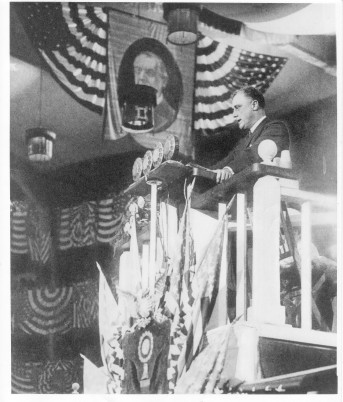
Franklin D. Roosevelt delivers nominating speech for Alfred E. Smith at the Democratic convention, Madison Square Garden, New York, New York. June 26, 1924.
1932 – First nomination for President
The 1932 convention pitted FDR, now governor of New York, against Al Smith and many others. The convention that year was held in Chicago, and after four contentious votes FDR was named as the Democratic nominee for the presidency.
When it came time to accept the nomination, FDR broke with tradition and flew to Chicago to address the convention in person. He acknowledged that fact in the beginning of his speech saying, “the appearance before a National Convention of its nominee for President, to be formally notified of his selection, is unprecedented and unusual, but these are unprecedented and unusual times.”
FDR went on to promise action and relief against the hardships caused by the Great Depression and pledged himself to a “new deal” for all Americans.
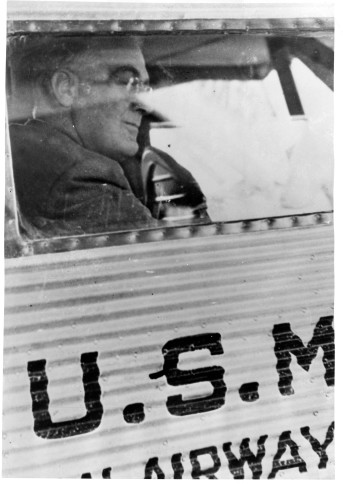
Franklin D. Roosevelt aboard airplane as it refuels in Cleveland, Ohio on his way to Chicago. July 2, 1932.
1936 – First re-election
Philadelphia was the site for the 1936 convention – a convention which was much calmer than that of 1932. FDR and Vice President John Nance Garner were nominated without the need of a roll call, and on June 27th, FDR addressed the convention.
As he spoke, he talked of the need for freedom from tyranny, both political and economic, and of making government the “embodiment of human charity.” FDR went on to say that “there is a mysterious cycle in human events. To some generations much is given. Of other generations much is expected. This generation of Americans has a rendezvous with destiny.”
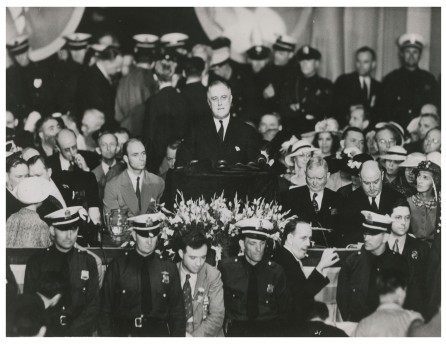
FDR accepts the nomination for the Presidency in speech at Franklin Field, Philadelphia, PA. June 27, 1936.
1940 – An unprecedented third term
1940 brought another convention first. After much speculation, FDR broke with presidential tradition and ran for a third term. While he was easily nominated on the first ballot, the convention was not without some controversy. This time it lay in the nomination of a vice-presidential candidate. The vote came down to two men, Henry Wallace and William Bankhead. FDR was adamant on Wallace being his running mate, but the convention was less convinced.
While FDR did not attend the convention, Eleanor was instead sent to deliver a speech in hopes of bringing together the party. In her address she called for unified action and support for the President. After her speech the convention voted, and Wallace was nominated. For more on Eleanor’s speech, please visit: https://fdrlibrary.wordpress.com/2011/07/21/found-in-the-archives-9/
1944 – A fourth term & final convention
The 1944 convention brought about the unprecedented nomination for a fourth term for FDR. Like the convention in 1940, FDR did not attend this convention. Instead, when the nomination was announced FDR was in California on his way to Hawaii to discuss military strategy for the ongoing war. Even with the easy nomination for FDR, this convention was not without controversy and contention.
Again, the controversy centered on the vice presidential nomination. By 1944 FDR’s health was steadily declining, and many delegates were opposed to Henry Wallace becoming FDR’s possible successor. Harry Truman was proposed as the vice presidential candidate, and though FDR knew little about Truman, he agreed to Truman’s nomination for the sake of party unity.
The Olympic Torch Stopped in Hyde Park
Excitement over the present-day Summer Games of the XXX Olympiad reminded us that the famous torch once paid a visit to the FDR Home and Library.
On February 4, 1932, Governor Franklin D. Roosevelt formally opened the III Olympic Winter Games in Lake Placid, NY.
On February 5, 1980, the Olympic torch relay carried the flame for the XIII Olympic Winter Games through the town of Hyde Park, NY before continuing northward to Lake Placid. The runners paused at FDR’s grave site for a torch lighting ceremony where they lit a 7-foot tall stationary torch commemorating the former Governor and President’s role in opening the 1932 Games, nearly 50 years prior.
Joan Barnum, a Hyde Park resident who coordinated the event, said the flame brought a “message of peace, truth, fraternity and love,” consistent with the Roosevelt legacy. Around 600 people attended the ceremony and observed a minute of silence to honor both the former President and the symbolic lighting. The graveside torch remained lit throughout the 1980 Winter Games.
March 4, 1933: FDR is inaugurated as the 32nd President of the United States.
- Franklin D. Roosevelt’s first Inaugural Address, pg 1
- Franklin D. Roosevelt’s first Inaugural Address, pg 9.
***********
Did you know…..
- On March 5, 1934, FDR outlined a program to create one million new jobs. He told a Washington audience of business and industrial leaders that the new jobs could be created if a general ten percent increase in wages was coupled with a ten percent decrease in hours.
- On March 2, 1945, FDR appointed his fourth secretary of commerce Henry A. Wallace. This was the last of his 25 cabinet appointments.
March 4, 1933: FDR is inaugurated as the 32nd President of the United States.
- Franklin D. Roosevelt’s first Inaugural Address, pg 1
- Franklin D. Roosevelt’s first Inaugural Address, pg 9.





